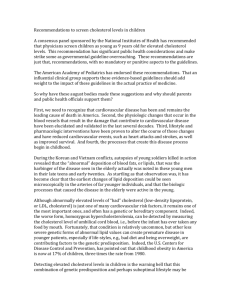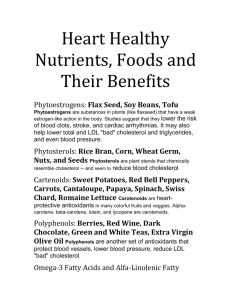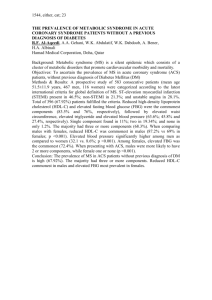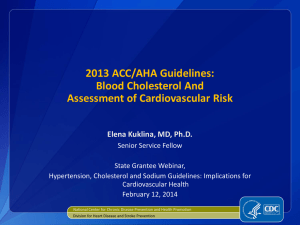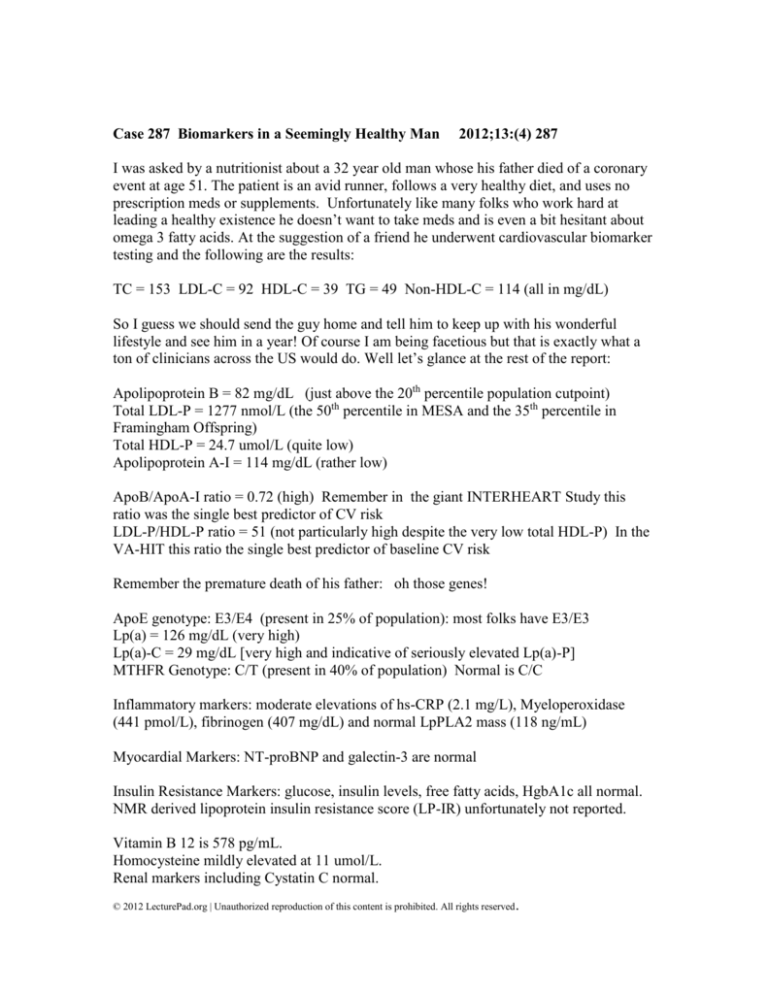
Case 287 Biomarkers in a Seemingly Healthy Man
2012;13:(4) 287
I was asked by a nutritionist about a 32 year old man whose his father died of a coronary
event at age 51. The patient is an avid runner, follows a very healthy diet, and uses no
prescription meds or supplements. Unfortunately like many folks who work hard at
leading a healthy existence he doesn’t want to take meds and is even a bit hesitant about
omega 3 fatty acids. At the suggestion of a friend he underwent cardiovascular biomarker
testing and the following are the results:
TC = 153 LDL-C = 92 HDL-C = 39 TG = 49 Non-HDL-C = 114 (all in mg/dL)
So I guess we should send the guy home and tell him to keep up with his wonderful
lifestyle and see him in a year! Of course I am being facetious but that is exactly what a
ton of clinicians across the US would do. Well let’s glance at the rest of the report:
Apolipoprotein B = 82 mg/dL (just above the 20th percentile population cutpoint)
Total LDL-P = 1277 nmol/L (the 50th percentile in MESA and the 35th percentile in
Framingham Offspring)
Total HDL-P = 24.7 umol/L (quite low)
Apolipoprotein A-I = 114 mg/dL (rather low)
ApoB/ApoA-I ratio = 0.72 (high) Remember in the giant INTERHEART Study this
ratio was the single best predictor of CV risk
LDL-P/HDL-P ratio = 51 (not particularly high despite the very low total HDL-P) In the
VA-HIT this ratio the single best predictor of baseline CV risk
Remember the premature death of his father: oh those genes!
ApoE genotype: E3/E4 (present in 25% of population): most folks have E3/E3
Lp(a) = 126 mg/dL (very high)
Lp(a)-C = 29 mg/dL [very high and indicative of seriously elevated Lp(a)-P]
MTHFR Genotype: C/T (present in 40% of population) Normal is C/C
Inflammatory markers: moderate elevations of hs-CRP (2.1 mg/L), Myeloperoxidase
(441 pmol/L), fibrinogen (407 mg/dL) and normal LpPLA2 mass (118 ng/mL)
Myocardial Markers: NT-proBNP and galectin-3 are normal
Insulin Resistance Markers: glucose, insulin levels, free fatty acids, HgbA1c all normal.
NMR derived lipoprotein insulin resistance score (LP-IR) unfortunately not reported.
Vitamin B 12 is 578 pg/mL.
Homocysteine mildly elevated at 11 umol/L.
Renal markers including Cystatin C normal.
© 2012 LecturePad.org | Unauthorized reproduction of this content is prohibited. All rights reserved .
Uric acid normal
Omega 3 Index very low at 4.3% (Desirable > 8%)
Markers of cholesterol absorption and synthesis (hope you all did the tutorial at
LecturePad
http://www.lecturepad.org/index.php?option=com_content&view=article&id=1010:chole
sterol-absorption-and-synthesis-markers-part-1&catid=54:hot-off-the-press&Itemid=265
Sitosterol, campesterol and cholestanol and their ratios to cholesterol demonstrate
hyperabsorption
Desmosterol (synthesis marker) normal
DAYSPRING ANALYSIS:
Just keep in mind that the above values are from a person who has a lifestyle better than
95% of Americans. Imagine what these biomarkers would be if he were the standard carb
loving couch potato. Any provider doing a history, physical and advanced biomarker
panels in all patients can come to an accurate risk assessment real quick: the key is to
glance over everything and then formulate a quick overall assessment and then go back
and review each marker in detail.
First off we have someone with an E4 allele: With respect to CV risk; E4/E4
have the highest, E3/E4 the next highest, E3/E3 the normal genotype and E2/E2
(typically low risk except for the few who have Type III dyslipoproteinemia). In anyone
with an E4 allele, Alzheimer’s disease becomes a legitimate concern (E4/E4 the highest).
With respect to CV risk, the E4 patients are more difficult to get to lipoprotein goals
© 2012 LecturePad.org | Unauthorized reproduction of this content is prohibited. All rights reserved .
The apoB and LDL-P are elevated and are fairly concordant, despite their
discordance with LDL-C. Increased numbers of potentially atherogenic articles is the
most important risk atherosclerosis risk factor. In part these elevations are driven in this
man by hyperabsorption of cholesterol (a major risk factor in numerous epidemiological
trials).
The HDL-C is low and the total HDL-P is very low and both are usually
independent risk factors: especially in the face of a high LDL-P. However LDL-P/HDL-P
ratio is only in the second quartile of the VA HIT data (see graph). We do not really
know about HDL functionality but the moderately elevated myeloperoxidase might
signify some HDL dysfunction (J Clin Lipidol 2010;4:382-388).
© 2012 LecturePad.org | Unauthorized reproduction of this content is prohibited. All rights reserved .
What about the very high Lp(a)-P. Lp(a) is a measure of the apo(a) mass which is
related both to the number of apo(a) molecules and the molecular weight (size) of the
apo(a) molecules. Since most people have more than one isoform of apo(a), apo(a) mass
measurement is not always correlated with Lp(a)-P meaning the number of LDL particles
carrying apo(a). A few molecules of the large, high molecular weight (MW) apo(a)
attached to LDLs would elevate Lp(a) mass but not Lp(a)-P. Conversely a lot of small,
low MW apo(a) molecules would attach to a lot more LDL particles and elevate both
Lp(a) mass and Lp(a)-P. At this time Lp(a)-C is the best biomarker we have of Lp(a)-P.
This man has very high Lp(a) mass and Lp(a)-C and thus has a high Lp(a)-P. If he had a
high Lp(a) and a normal LP(a)-C he would have a low Lp(a)-P and not be at risk.
Therefore in this case with both elevated Lp(a) and Lp(a)-C we are dealing with a high
Lp(a)-P. Thus the total LDL-P is even more worrisome as a lot of his LDLs are carrying
an atherogenic protein and it becomes necessary to aggressively lower total LDL-P. For
an in depth, illustrated discussion of Lp(a) please go to www.FHIT.com and click on
Biomarker Bliki and then read the bliki dealing with Lp(a).
© 2012 LecturePad.org | Unauthorized reproduction of this content is prohibited. All rights reserved .
This patient has definite hyperabsorption of cholesterol as evidenced by the elevated
campesterol level and sitosterol/C and cholestanol/C ratios. When present in elevated
amounts phytosterol as well as stanol molecules (such as cholestanol) that are not
normally absorbed are the clinical biomarkers indicative of hyperabsorption. Interestingly
the desmosterol, the cholesterol synthesis marker is normal. Typically in hyperabsorbers
there is a reflex suppression of cholesterol synthesis. However, in persons with E4 on
their lipoproteins, there is impaired clearance their apoE-containing containing particles
and their cholesterol content. In essence there is diminished indirect reverse cholesterol
transport. The liver compensates by increasing synthesis (in this case from hypo to
normal).
The low omega 3 index is a marker of both atherosclerotic risk and sudden death risk
(remember his father?). For an excellent, illustrated discussion of this biomarker please
go to the bliki web site written by Dr. Willam Harris. Seeming it is hard to imagine how a
person of his lifestyle could be so deficient in eicosapentaenoic (EPA) and
docosahexaenoic (DHA) acid. He is likely eating a lot of veggies which contain alphalinolenic acid (an 18 carbon omega 3 fatty acid) – but few humans convert much of that
to EPA and DHA.
I’d like to add a little Fatty acid biochemistry nomenclature here:
EPA is eicosapentaenoic acid and DHA is docosahexaenoic acid:
Eicosa = 20
Docosa = 22
Penta = 5
Hexa = 6
Enoic = double bond
EPA = a 20 carbon molecule with5 double bonds
© 2012 LecturePad.org | Unauthorized reproduction of this content is prohibited. All rights reserved .
DHA = a 22 carbon molecule with 6 double bonds
Because the location of the first double bond is at the third carbon form the terminal
methyl end of the fatty acid, such fatty acids are call n3 fatty acids or because omega (Ώ)
is the last (terminal) letter in the Greek alphabet, Ώ-3 fatty acids.
The low Omega-3 index always worries me in persons with E4 alleles because of the E4
association with Alzheimer’s. DHA is a crucial brain fatty acid. I have no proof that it is
necessary but I like to prescribe whatever dose it takes to keep the levels of DHA normal
in such patients. What is the downside?
There is moderate elevation of several inflammatory markers: all convey
independent risk. It is again interesting that the MPO, an oxidative marker is abnormal in
face of the lifestyle. Even worse is that MPO can affect tyrosine molecules in apoA-I
leading to its destruction or inactivity and thus impair HDL function. Decreased HDL
functionality is not exactly what we want to see in someone with a very low HDL-P.
MTHFR T allele with mild homocysteine elevation and a relatively low B12 are
present. Uric acid is normal. Both the MTHFR T genotype (JAMA 2002;208:2023-2031)
as well as the elevated homocysteine are associated with CV risk. As stated in a review
(Circulation. 2005;111:e289-e293): “The MTHFR gene produces an enzyme that helps
regulate homocysteine levels in the body. If there is a genetic error (called a mutation) in
the MTHFR gene, homocysteine levels may not be regulated properly. Genetic mutations
in MTHFR are the most commonly known inherited risk factor for elevated homocysteine
levels. --- Having only one mutation, ie, being heterozygous, is, from a medical
© 2012 LecturePad.org | Unauthorized reproduction of this content is prohibited. All rights reserved .
perspective, irrelevant. Even when 2 MTHFR mutations are present (eg, 2 C677T
mutations, or one C677T mutation and one A1298C mutation), not all people will
develop high homocysteine levels. Although these mutations do impair the regulation of
homocysteine, adequate folate levels essentially “cancel out” this defect.” Homocysteine
can be recycled into methionine or converted into cysteine with the aid of B-vitamins. If
one wanted to treat this homocysteine elevation, supplemental B12, and because of the T
allele being present, methyl folate rather than or in addition to folic acid would likely
needed.
In this case the friend who encouraged this man to get properly tested may have saved his
life. In essence, a man who thought he was in perfect health discovered that despite his
excellent lifestyle abnormal genes have caused a too high LDL-P and apoB and a very
severe reduction in HDL-P (very high LDL-P/HDL-P ratio). The CV risk is made even
worse by the severe elevations of Lp(a), Lp(a)-C and thus Lp(a)-P. Adding to the risk is
the presence of an E4 allele, elevated inflammatory markers, MTHFR with a T allele and
a high homocysteine, borderline B12, marked hyperabsorption of cholesterol and a very
low Omega 3 index. Both the E4 allele presence and perhaps the low Omega 3 index add
to the risk for Alzheimer's disease. The presence of all of these in a person doing good
lifestyle means serious pharmacological intervention will be required to ameliorate that
risk. The man may not want to hear it, bit all he has to do is visit his father’s grave to
develop a sense of reality.
Because of his running and high physical activity I would do a stress/echo on this man:
we do not need another Jim Fixx (athlete with a sudden death). With respect to therapy, I
am very worried about this man and consider him to be at high or very high lifetime risk
for an atherothrombotic event. Right now there is not a lot of evidence for insulin
© 2012 LecturePad.org | Unauthorized reproduction of this content is prohibited. All rights reserved .
resistance (if there was then the lifestyle has ameliorated it). Because of the risk, and
especially the high Lp(a)-P, we need to lower total LDL-P (well under 1000 nmol/L) and
apoB (well under 80 mg dL). In the face of a hyperabsorptive scenario a statin plus
ezetimibe combination is likely to accomplish that. Keep in mind that the therapeutic
mission in patients with elevated Lp(a)-P is to normalize total LDL-P not to lower Lp(a)
mass per se. Although intuitively it may make sense there is no clinical trial proof that the
latter is required. In persons with elevated Lp(a)-P only some of the LDL particles in the
plasma carry the apo(a). Apo(a) attaches to the part of apoB that contains the domain to
which LDL receptors (LDLr) bind. Thus it is very difficult for an LDLr to attach to and
endocytose an Lp(a) particle. Fortunately in patients with elevated Lp(a) mass many
LDLs are present that do not contain apo(a) and those LDLs are very amenable to
removal by upregulation of LDLr (statins, ezetimibe, colesevelam). This explains why
statins lower LDL-P but not Lp(a). Niacin of course is typically added to a statin in such
cases because of its ability to somewhat reduce apo(a) mass (mechanism unknown). Of
course niacin also lowers total LDL-P (apoB) beyond what a statin can do so in most
cases statin/niacin makes great sense. However data from HATS reveal statin/niacin
combination aggravates sterol absorption (J. Lipid Res.2003;44:800–806) whereas
statin/ezetimibe would correct the hyperabsorptive state. In many patients with
significant elevations of total LDL-P, statin + niacin + ezetimibe are needed to achieve
total LDL-P or apoB goals.
Because of the E4 association with Alzheimer’s and the very low Omega 3 index I’d be
heavy with EPA/DHA supplementation (3-4 grams a day). I also believe we can
beneficially impact Alzheimer’s incidence with prevention of insulin resistance and I’d
keep a very close eye on several IR markers in this man (not wait for glucose to start
rising). Somewhere in their mid-forties or at 50, I think E4 patients need sophisticated
© 2012 LecturePad.org | Unauthorized reproduction of this content is prohibited. All rights reserved .
neurologic exams looking for short term memory defects and if present consideration for
existing drugs that may delay the onset of AD.
I tend to prescribe some dose of aspirin to patients with elevated Lp(a)-P, but it would be
best to do a urine 11-dehydro thromboxane B2 (AspirinWorks) level to look for in vivo
platelet hyper-reactivity. Once on platelet inhibition therapy the test can evaluate the
response to therapy. Thromboxane A2 is generated by thromboxane synthase from
molecules derived from arachidonic acid by cyclooxygenase-1 (COX-1). Thromboxane
A2 has a short half-life in plasma and is rapidly hydrolyzed to thromboxane B2 (TxB2).
TxB2, in turn, is metabolized to 11-Dehydro Thromboxane B2 and excreted into the
urine where it can be measured.
Initial pharmacotherapy in such a case would be a statin/cholesterol absorption blocker
combo (Vytorin 10/10), 4 grams Omega-3 fatty acids, folic acid/B12 or methylfolate/B12
supplementation. The newsletter will discuss this patient in immense depth.
TAKE HOME POINTS:
1) Unless they are grossly abnormal, lipid profiles are often useless for accurate CV
risk evaluation
2) Lp(a) mass is not always a predictor of Lp(a)-P. Lp(a)-C is a better surrogate
3) Apolipoprotein E4 status is a marker of increased CV risk, predictor of treatment
difficulties and a predictor of Alzheimer’s disease the risk of which may be
ameliorated with lifestyle and meds.
© 2012 LecturePad.org | Unauthorized reproduction of this content is prohibited. All rights reserved .
4) Even in persons with seemingly perfect lifestyles, serious CV risk can exist and if
they are not serious fatty fish eaters the Omega-3 index may be low
5) The type of methylation therapy directed at elevated homocysteine can be better
predicted by the MTHFR T allele
6) Satins alone or statins + niacin lower apoB but are associated with increased
cholesterol absorption
7) Platelet reactivity tests can be very useful in making decisions on anti-platelet
therapy and in monitoring it.
© 2012 LecturePad.org | Unauthorized reproduction of this content is prohibited. All rights reserved .

